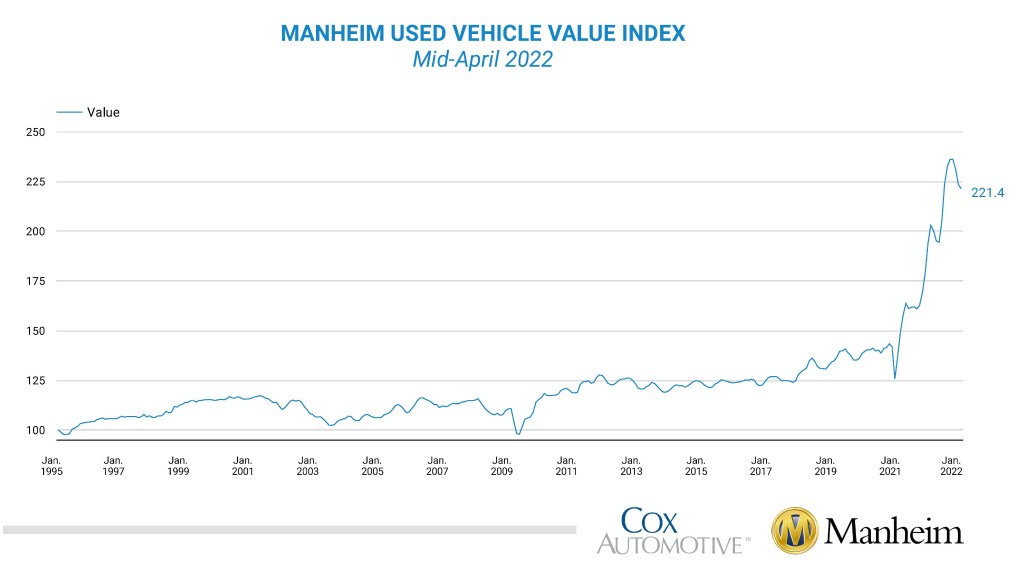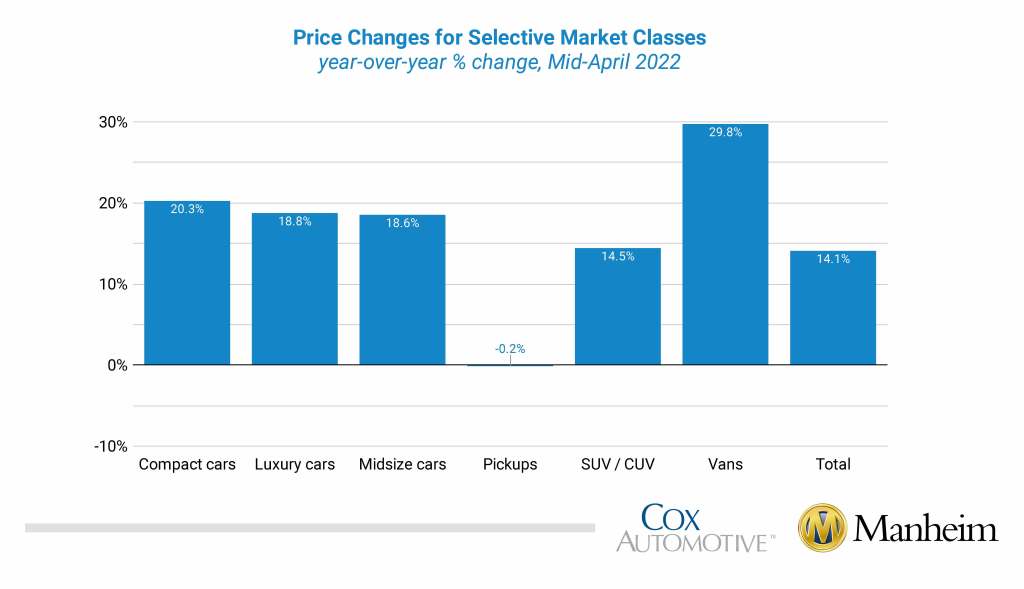Data Point
Wholesale Used-Vehicle Prices Decline in First Half of April From Seasonal Adjustment
Tuesday April 19, 2022
Article Highlights
- Wholesale used-vehicle prices (on a mix-, mileage-, and seasonally adjusted basis) declined 1.0% in the first 15 days of April compared to the full month of March.
- This brought the Manheim Used Vehicle Value Index to 221.4, which was up 14.1% from April 2021.
- The non-adjusted price change in the first half of April was an increase of 3.0% compared to March, leaving the unadjusted average price up 16.4% year over year.
Wholesale used-vehicle prices (on a mix-, mileage-, and seasonally adjusted basis) declined 1.0% in the first 15 days of April compared to the full month of March. This brought the Manheim Used Vehicle Value Index to 221.4, which was up 14.1% from April 2021. The non-adjusted price change in the first half of April was an increase of 3.0% compared to March, leaving the unadjusted average price up 16.4% year over year.
Manheim Market Report (MMR) prices saw consistent gains over the first two full weeks of April. The Three-Year-Old MMR Index, which represents the largest model-year cohort at auction, experienced a 1.0% cumulative increase over the last two weeks. Over the first 15 days of April, MMR Retention, which is the average difference in price relative to current MMR, averaged 99.4%, which indicates that valuation models are slightly ahead of market prices. The average daily sales conversion rate of 59.2% in the first half of April increased relative to March’s daily average of 56.7% and has been slightly lower than the typical conversion rate this time of year. The latest trends in the key indicators suggest wholesale used-vehicle values will likely see increases in the second half of the month.
Most major market segments saw seasonally adjusted prices that were higher year over year in the first half of April. Pickups were the exception with a 0.2% decline year over year. Vans had the largest increase at 29.8%, and both non-luxury car segments outpaced the overall industry in seasonally adjusted year-over-year gains. Compared to March, major segment performance was mixed with vans and luxury cars seeing seasonally adjusted price increases, while other segments saw declines and compact cars declined the most. The seasonal adjustment drove the declines, as all major market segments saw gains from March with luxury cars increasing the most, and pickups increased the least.
Wholesale supply up slightly in April. Using estimates based on vAuto data as of April 11, used retail days’ supply was 44 days, which was down one day from the end of March. Days’ supply was up 13 days year over year. Leveraging Manheim sales and inventory data, we estimate that wholesale supply ended March at 23 days, down five days from end of February but up six days year over year. As of April 15, wholesale supply was at 24 days, up one day from the end of March but up eight days year over year.
Rental risk prices decline. The average price for rental risk units sold at auction in the first 15 days of April was up 18.8% year over year. Rental risk prices were down 2.6% compared to the full month of March. Average mileage for rental risk units in the first half of March (at 64,100 miles) was down 22.6% compared to a year ago and up 2.0% month over month.
Auto loan performance improves in March while credit expands again. Auto loan performance improved in March as the flow of tax refunds helped consumers catch up on delinquencies. For the first time in 10 months, delinquencies of over 60 days declined but were still up 10.0% year over year. In March, 1.49% of auto loans were severely delinquent, which was a decline from 1.58% in February. Compared to a year ago, the severe delinquency rate was 14 basis points higher. In March, 5.65% of subprime loans were severely delinquent, which was a decline from 5.99% in February. The subprime severe delinquency rate was 70 basis points higher year over year. Higher delinquencies are still not leading to pre-pandemic levels of defaults, and defaults declined in March. Loan defaults declined 4.3% in March from February and were down 2.6% year over year. Auto credit access expanded in March. The Dealertrack Credit Availability Index for all loans was at the highest recorded level in the data series going back to January 2015. All loan channels and most lender types saw improving credit access even as rates moved higher.
The complete suite of monthly MUVVI data for April will be released on May 6, 2022, the fifth business day of the month as regularly scheduled. If you have any questions regarding the Index or would like to sign up for updates, please contact the Cox Automotive Industry Insights team at Manheim.Data@coxautoinc.com.


